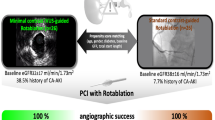Abstract
Radiocontrast-induced nephropathy (CIN) is one of the most serious complications of percutaneous coronary interventions (PCI). The prevention of PCI-related CIN for chronic kidney disease (CKD) patients has not been established yet. The intravascular ultrasound (IVUS) is commonly used as an imaging device during PCI. We performed IVUS-guided PCI while only using fluoroscopic imaging and without administering any routine contrast dye injection during the procedures. All patients underwent a baseline coronary angiography prior to the elective PCI. During the PCI, all the following procedures were done with X-ray fluoroscopic imaging without or with a minimized contrast dye injection: the engagement of the guiding catheter, insertion of the coronary guidewire, insertion of the IVUS catheter, the stent deployment and the post-dilatation. The diameter and the length of the balloon and the stent were determined according to the pre-procedural IVUS findings, and the end point of the stent dilatation was also judged according to the acquired minimal cross-sectional area of the stent. Here we report our findings from two cases representative of IVUS-guided minimum contrast PCI in which the volumes of contrast dye during the procedure were 5 and 4 ml, respectively. No CIN occurred after either procedure. The IVUS-guided minimum contrast PCI could be a promising option for the prevention of CIN after PCI.



Similar content being viewed by others
Abbreviations
- CIN:
-
Radiocontrast-induced nephropathy
- CKD:
-
Chronic kidney disease
- PCI:
-
Percutaneous coronary intervention
- IVUS:
-
Intravascular ultrasound
- DES:
-
Drug-eluting stent
References
Toprak O. Risk markers for contrast-induced nephropathy. Am J Med Sci. 2007;334(4):283–90.
Sterling KA, Tehrani T, Rudnick MR. Clinical significance and preventive strategies for contrast-induced nephropathy. Curr Opin Nephrol Hypertens. 2008;17(6):616–23.
Sonoda S, Morino Y, Ako J, Terashima M, Hassan AH, Bonneau HN, Leon MB, Moses JW, Yock PG, Honda Y, Kuntz RE, Fitzgerald PJ. Impact of final stent dimensions on long-term results following sirolimus-eluting stent implantation: serial intravascular ultrasound analysis from the sirius trial. J Am Coll Cardiol. 2004;43(11):1959–63.
Zagler A, Azadpour M, Mercado C, Hennekens CH. N-Acetylcysteine and contrast-induced nephropathy: a meta-analysis of 13 randomized trials. Am Heart J. 2006;151(1):140–5.
Weisbord SD, Mor MK, Resnick AL, Hartwig KC, Sonel AF, Fine MJ, Palevsky PM. Prevention, incidence, and outcomes of contrast-induced acute kidney injury. Arch Intern Med. 2008;168(12):1325–32.
Wang JH, Subeq YM, Tsai WC, Lee RP, Hsu BG. Intravenous N-acetylcysteine with saline hydration improves renal function and ameliorates plasma total homocysteine in patients undergoing cardiac angiography. Ren Fail. 2008;30(5):527–33.
Pannu N, Wiebe N, Tonelli M. Prophylaxis strategies for contrast-induced nephropathy. JAMA. 2006;295(23):2765–79.
Carbonell N, Blasco M, Sanjuan R, Perez-Sancho E, Sanchis J, Insa L, Bodi V, Nunez J, Garcia-Ramon R, Miguel A. Intravenous N-Acetylcysteine for preventing contrast-induced nephropathy: a randomised trial. Int J Cardiol. 2007;115(1):57–62.
Baker CS, Wragg A, Kumar S, De Palma R, Baker LR, Knight CJ. A rapid protocol for the prevention of contrast-induced renal dysfunction: the RAPPID study. J Am Coll Cardiol. 2003;41(12):2114–8.
Masuda M, Yamada T, Mine T, Morita T, Tamaki S, Tsukamoto Y, Okuda K, Iwasaki Y, Hori M, Fukunami M. Comparison of usefulness of sodium bicarbonate versus sodium chloride to prevent contrast-induced nephropathy in patients undergoing an emergent coronary procedure. Am J Cardiol. 2007;100(5):781–6.
Thomsen HS, Morcos SK, Barrett BJ. Contrast-induced nephropathy: the wheel has turned 360 degrees. Acta Radiol. 2008;49(6):646–57.
Kane GC, Doyle BJ, Lerman A, Barsness GW, Best PJ, Rihal CS. Ultra-low contrast volumes reduce rates of contrast-induced nephropathy in patients with chronic kidney disease undergoing coronary angiography. J Am Coll Cardiol. 2008;51(1):89–90.
Author information
Authors and Affiliations
Corresponding author
Rights and permissions
About this article
Cite this article
Ogata, N., Matsukage, T., Toda, E. et al. Intravascular ultrasound-guided percutaneous coronary interventions with minimum contrast volume for prevention of the radiocontrast-induced nephropathy: report of two cases. Cardiovasc Interv and Ther 26, 83–88 (2011). https://doi.org/10.1007/s12928-010-0037-9
Received:
Accepted:
Published:
Issue Date:
DOI: https://doi.org/10.1007/s12928-010-0037-9




